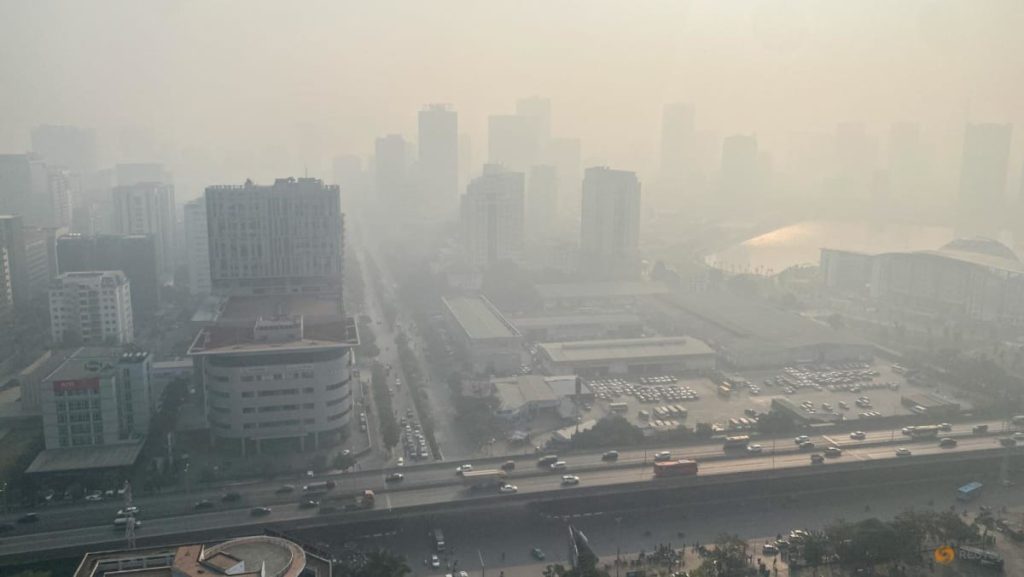Hanoi, Vietnam’s capital, is grappling with a pervasive air pollution problem that is impacting residents of all ages. The city’s air quality has deteriorated, causing respiratory issues and general discomfort among its citizens. Elderly residents like Luu Minh Duc, 64, are acutely aware of the worsening air quality, experiencing breathing difficulties exacerbated by the pollution. Younger residents are not immune either, with students like 21-year-old Nguyen Ninh Huong mistaking the haze for fog, only to realize it’s fine dust particles affecting visibility and respiratory health. This widespread concern about air quality has prompted calls for government action to address the issue.
The primary culprit behind Hanoi’s air pollution crisis is the high concentration of fine particulate matter, also known as PM2.5. These microscopic particles, smaller than 2.5 micrometers in diameter, can penetrate deep into the lungs and even enter the bloodstream, posing significant health risks. The sources of PM2.5 pollution are multifaceted, including vehicle emissions, industrial activities, construction dust, and the burning of biomass for cooking and heating. Hanoi’s rapid urbanization and increasing industrialization have contributed to a surge in these sources, leading to a dramatic rise in PM2.5 levels. The situation is further aggravated by meteorological factors, such as low wind speeds and temperature inversions, which trap pollutants near the ground, creating a thick haze over the city.
Recognizing the gravity of the situation, Vietnam’s government has taken some steps to address the air pollution crisis. Deputy Prime Minister Tran Hong Ha has emphasized the need for an accelerated transition to electric vehicles (EVs) to reduce emissions from the transportation sector. The government has set a target for at least 50% of buses and 100% of taxis in Hanoi to be electric by 2030. This initiative aims to curb vehicular emissions, a major contributor to air pollution. However, the effectiveness of this plan hinges on its implementation and the development of necessary infrastructure, such as charging stations and a reliable electricity grid.
While the government’s focus on electric vehicles is a positive step, a comprehensive approach is necessary to tackle the multifaceted nature of air pollution. This includes stricter regulations on industrial emissions, controlling construction dust, promoting cleaner cooking fuels, and investing in public transportation. Furthermore, regional cooperation is crucial, as air pollution transcends national boundaries. Transboundary haze from neighboring countries can significantly impact Hanoi’s air quality, highlighting the need for collaborative efforts to address the issue on a regional scale. Public awareness campaigns are also essential to educate the public about the health risks of air pollution and encourage individual actions to mitigate the problem.
The health consequences of prolonged exposure to high levels of air pollution are severe. Respiratory illnesses, such as asthma and bronchitis, are on the rise, particularly among vulnerable populations like children, the elderly, and those with pre-existing respiratory conditions. Fine particulate matter can also exacerbate cardiovascular diseases and increase the risk of stroke and heart attack. Moreover, air pollution has been linked to developmental problems in children and can negatively impact cognitive function. The economic implications of air pollution are also significant, as healthcare costs associated with pollution-related illnesses place a burden on the healthcare system. Reduced productivity due to illness and premature mortality further contribute to the economic toll of air pollution.
The situation in Hanoi underscores the urgent need for a comprehensive and coordinated approach to tackle air pollution. While the government’s push for electric vehicles is a step in the right direction, it must be complemented by a range of measures targeting various sources of pollution. Stricter enforcement of environmental regulations, investment in clean energy, and regional cooperation are crucial to mitigating the health and economic impacts of air pollution. Public awareness campaigns can empower individuals to take proactive steps to protect their health and contribute to a cleaner environment. Ultimately, addressing the air pollution crisis requires a sustained, multi-pronged approach involving government, industry, and individuals working together to create a healthier and more sustainable future for Hanoi and its residents.

